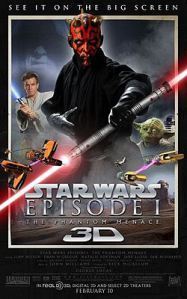Phantom Menace
 A long time ago, in a cinema not too far away, George Lucas complicated things by releasing The Phantom Menace, the first in a series of three prequels that transformed the Star Wars trilogy into a hexalogy, and, yes, that’s a real word.
A long time ago, in a cinema not too far away, George Lucas complicated things by releasing The Phantom Menace, the first in a series of three prequels that transformed the Star Wars trilogy into a hexalogy, and, yes, that’s a real word.
Star Wars is iconic, but it is not beyond reproach, and with a reboot or extension in the works for 2015, I thought it was worth looking back at The Phantom Menace to see what worked well and what didn’t.
Who doesn’t love a good light-sabre duel? The Phantom Menace has arguably the best sword fight in the series, and yet The Menace is widely regarded as the worse of the Star Wars movies.
The Phantom Menace is an enigma. I’m not sure anyone knows quite what to do with it. Empire magazine rated it as one of the greatest movies of all time, while Entertainment Weekly considered it one of the worst sequels/prequels ever made.
With a new Star Wars movie slated for 2015, I thought it would be interesting to look at the highs and lows of The Phantom Menace.
OK, lets get the lows over with as quickly as possible…
What was it with Jar Jar Binks and the whole racial overtones of the Caribbean-like Gungans? Not to mention the frugal, angry Jewish stereotype in Watto.
“Me’s a thinks he’s a insulting deem dat donna speaka American as dear first language.”
There’s only one possible explanation for Jar Jar Binks, and it’s the same as for the Ewoks: George was trying to market a cute and cuddly toy for kids. And that’s no surprise, as George has made twenty billion dollars on the back of merchandising. One only wishes it had been money well spent on things other than Jar Jar.
Between Jar Jar Binks, the morally bankrupt position of putting a nine-year old in a life-and-death pod race, and an anorexic army of incompetent robots, The Phantom Menace skirts with disaster.
The redeeming factors in The Phantom Menace are that we get our first glimpse of a fully qualified Jedi Knight and the breathtaking contrasts in exotic settings.
When Star Wars first hit the silver screen in 1977, it was the opening minute that whisked me away into another galaxy: A rebel cruiser flew over a desert world, taking fire from some unseen pursuer, and then the theatre started to shake as a Star Destroyer slowly filled the screen. That there was no sound in space was the furtherest thing from my mind, it was the audacious scale of the adventure that caused me to suspend my disbelief.
The original Star Wars (sorry, I can’t bring myself to call it episode IV) was breathtaking because of the scope of its vision. From a battle in space, to a desert planet, from a cantina full of strange aliens, to the inside of the Death Star and on, Star Wars was a swashbuckling adventure.
And that’s where The Phantom Menace succeeds. In the Menace, we see trade federation battleships, the idyllic planet Naboo, the 50s style retro spaceships of Queen Amidala, the desert world of Tatooine and the city-planet of Coruscant. And it’s these sweeping locations that anchors the sense of adventure.
But perhaps the most iconic aspect of Star Wars is the light-sabre.
And when it comes to The Phantom Menace, the swashbuckling, high-seas adventure was reinforced with a dual of epic proportions.
Star Wars has always been about the battle between good and evil, and nowhere is this more vividly displayed than in the face of the devilish Darth Maul. The powerplays and intrigue surrounding the Sith wasn’t always believable but it did add an element of depth to the story.
If anything, this antagonist was killed off too soon. Although it’s worth noting that in the animated series The Clone Wars, Darth Maul survives and is given robotic legs so as to continue his demonic quest.
When it comes to the reboot of Star Wars, or its continuation, or whatever happens to the story in 2015, I hope the screenwriters, producers and directors look carefully at what worked and what didn’t in movies like The Phantom Menace.
In 2009, Star Trek was rebooted and although we gained a heart-pounding, adrenalin-filled action/adventure story, we lost the concept of boldly going where no one had gone before. Instead of the excitement of discovery, we were given Mission Impossible in space. Not that this is a bad thing, but it does detract from the original intent of Star Trek (ie, the trek into the unknown).
When it comes to Star Wars 2015, I hope we don’t get Mission Impossible with light sabres. Star Wars has so much richness and so many possibilities left to explore. The Phantom Menace gave us a glimpse of what was possible, and I hope the new movies continue the swashbuckling adventure with style and aplomb.








